Are you curious about what a tarot card reading entails? Perhaps you’ve heard about tarot cards and their mystical powers, but you’re not quite sure what to expect during a reading. Well, look no further! In this article, we will guide you step-by-step through the process of a tarot card reading, from understanding what tarot is to interpreting the cards and finding the right reader for you. Whether you’re a tarot enthusiast or a complete novice, we’ve got you covered. So, sit back, relax, and embark on a journey of self-discovery as we unravel the mysteries of the tarot.
Contents
- What is Tarot?
- How Does a Tarot Card Reading Work?
- Preparing for a Tarot Card Reading
- What to Expect During the Reading
- Interpreting the Tarot Card Reading
- Common Tarot Card Spreads
- Ending the Tarot Card Reading
- What to Do After the Reading
- Benefits of Tarot Card Readings
- How Often Should You Get a Tarot Card Reading?
- Choosing a Tarot Card Reader
- Final Thoughts
- Conclusion
-
Frequently Asked Questions
- What can tarot cards reveal about my future?
- Can anyone learn to read tarot cards?
- Are online tarot readings accurate?
- Do tarot cards have negative or scary meanings?
- Is a tarot reading limited to a specific time frame?
- Can tarot cards provide solutions or make decisions for me?
- Can I ask specific questions during a tarot reading?
- How long does a tarot reading usually last?
- Can tarot cards reveal information about my love life?
- Are tarot readings only for predicting events, or can they offer personal growth?
- References
What is Tarot?
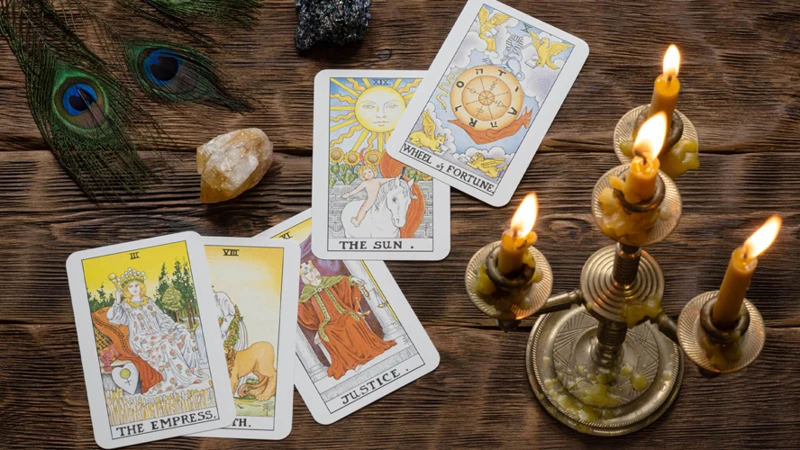
Tarot is a divination tool that has been used for centuries to gain insight into the past, present, and future. It is a deck of 78 cards, divided into the Major Arcana and the Minor Arcana, each with its own unique symbolism and meaning. The Major Arcana consists of 22 cards representing significant life events and archetypal energies. The Minor Arcana, on the other hand, is divided into four suits (Wands, Cups, Swords, and Pentacles) and represents everyday experiences and challenges. Each card in the deck carries a specific message or lesson, which is interpreted by the reader during a tarot card reading. Tarot readings are not fortune-telling sessions but rather opportunities for self-reflection and guidance. The cards serve as a visual tool to help tap into the subconscious mind and navigate through life’s uncertainties. So, if you’re seeking clarity, spiritual guidance, or a deeper understanding of yourself and your life path, a tarot card reading can be a transformative experience. It is important to approach tarot with an open mind and trust in the process. Don’t forget to check our article on tips for finding an authentic psychic if you’re looking for a trustworthy reader to guide you on your journey.
How Does a Tarot Card Reading Work?
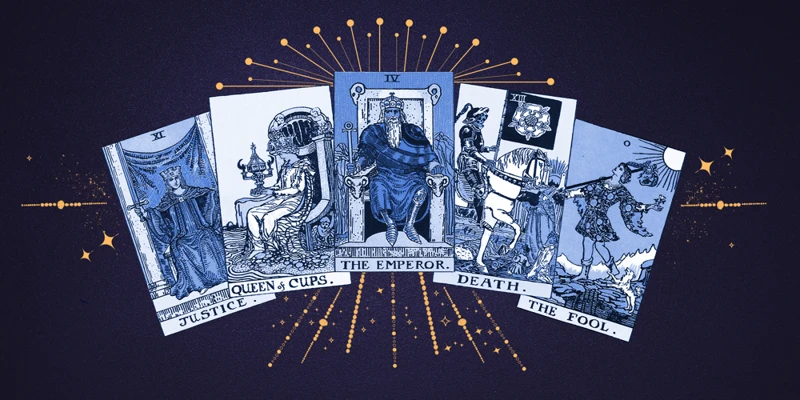
A tarot card reading works by tapping into the energy of the individual and the collective unconscious. The reader, often referred to as a tarot reader or psychic, uses the tarot deck as a tool to connect with the seeker’s energy and receive guidance from the spiritual realm. During a reading, the seeker typically asks a question or discusses a specific area of their life they would like insight on. The reader then shuffles the deck while focusing on the question or area of concern. The shuffling process helps to clear the energy and bring the reader’s awareness to the seeker’s question. Once the cards are shuffled, the reader asks the seeker to choose a specific number of cards from the deck. The cards selected are then laid out in a specific pattern or spread, which determines their position and significance. The reader starts interpreting each card, considering its symbolism, numerology, and the seeker’s intuition and energy. The interpretation provides guidance, insights, and potential outcomes related to the seeker’s question or area of concern. During the reading, the seeker is encouraged to ask questions, share thoughts, and provide additional context to ensure a deeper understanding of the messages being conveyed by the cards. It’s important to note that a tarot reading is not set in stone and that individuals still have free will and the ability to make choices that can change or influence the outcome. For a more in-depth exploration of the tarot reading process and its benefits, you can check out our article on the benefits of in-person psychic readings.
Preparing for a Tarot Card Reading
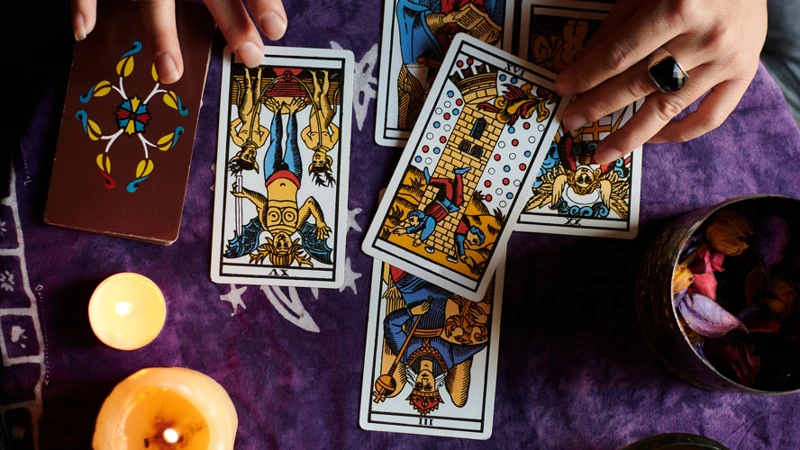
Preparing for a tarot card reading can enhance your overall experience and ensure that you make the most out of your session. Here are some tips to help you get ready for your reading:
1. Set an Intention: Before your reading, take a moment to reflect on your purpose for seeking guidance. Set a clear intention for what you hope to gain from the reading. This will help the reader focus their energies and provide you with more relevant insights.
2. Come with an Open Mind: Approach the reading with an open and receptive mindset. Leave any skepticism or preconceived notions at the door. Remember, the tarot cards are a tool for self-reflection and guidance, so be willing to receive the messages they have to offer.
3. Write Down Your Questions: Jot down any specific questions or areas of your life that you would like guidance on. This will help you stay focused during the reading. Having your questions written down can also help you remember important points discussed during the session.
4. Choose the Right Environment: Find a quiet and comfortable space where you can relax and concentrate during the reading. Minimize distractions and create a serene atmosphere that allows you to connect with your inner self. If possible, consider scheduling an in-person tarot card reading, as the physical presence can enhance the energy exchange.
5. Clear Your Mind: Prior to the reading, take a few moments to clear your mind and release any stress or tension. You can do this through deep breathing, meditation, or any other relaxation technique that works for you. The clearer your mind, the better you’ll be able to receive the insights and guidance offered by the cards.
By following these preparatory steps, you can create an optimal environment for your tarot card reading and open yourself up to the transformative power of the cards. Remember, each reading is a unique experience, and the more prepared and open you are, the more fruitful and insightful your session is likely to be.
What to Expect During the Reading

During a tarot card reading, there are several things you can expect to experience. First, the reader will begin by shuffling the cards to infuse them with your energy and intentions. This step is important as it helps create a connection between you, the reader, and the cards. Once the cards are shuffled, the reader will ask you to select a certain number of cards from the deck. The cards you choose are believed to be a reflection of your subconscious mind and the energies surrounding you. The reader will then interpret the meaning of each card and how they relate to your situation or question. This interpretation is based on the symbolism and traditional meanings associated with each card. Throughout the reading, you can expect a discussion with the reader, where they will encourage you to ask questions or provide additional insights. This dialogue is crucial for a more personalized and meaningful reading. Tarot card readings are subjective and can vary depending on the reader’s style and interpretation, so it’s important to choose a reader who resonates with you. The experience of a tarot card reading can range from introspective and thought-provoking to deeply emotional and enlightening. It’s important to approach the reading with an open mind and a willingness to explore the messages that come through the cards.
Shuffling of the Cards
During a tarot card reading, the shuffling of the cards is an important ritual that sets the stage for the reading. The process of shuffling helps to infuse the cards with the energy of the seeker and the reader. The reader may ask the seeker to shuffle the deck themselves or perform the shuffling on their behalf. This step is typically done with focus and intention, allowing the energy to flow into the cards. Some readers may use different shuffling techniques, such as overhand shuffling or riffle shuffling, while others may prefer to simply mix the cards together thoroughly. The goal of shuffling is to randomly rearrange the cards so that they are ready to provide guidance and insight for the seeker. Once the cards have been shuffled, the reader will move on to the next step of the reading, which is the selection of the cards.
Card Selection
Card selection is an essential step in a tarot card reading. After the deck has been shuffled, the reader will ask you to select a certain number of cards from the deck. The number of cards chosen can vary depending on the reading style or spread being used. Each card selected holds significance and contributes to the overall message and theme of the reading.
There are several methods for card selection. The most common method is to have the querent (person receiving the reading) shuffle the cards while focusing on their question or situation. Once they feel ready, they will hand the deck back to the reader, who will then select the cards based on intuition or as guided by the querent’s energy.
Another method is to fan out the deck and have the querent choose cards randomly or based on their intuition. Some readers may also use a specific card-cutting technique, where the querent cuts the deck into multiple piles, and the reader selects cards from those piles.
The selection process is not just about randomly picking cards. It is believed that the cards chosen are not a coincidence but rather a synchronistic connection between the querent, the reader, and the cards themselves. The selected cards will reflect the energies and messages that need to be conveyed during the reading. It is important to note that the reader is not manipulating the cards or forcing a specific outcome but rather tapping into the collective unconscious and the wisdom of the tarot.
So, as you embark on your tarot card reading journey, remember that the cards chosen during the selection process hold hidden wisdom and guidance specifically meant for you. Embrace the mystery and trust in the process as you explore the depths of the tarot’s wisdom.
Card Interpretation
Card interpretation is one of the most crucial aspects of a tarot card reading. Once the cards have been selected, the reader begins analyzing their meanings and how they relate to the querent’s question or situation. Each card holds its own symbolism, imagery, and energy, which the reader interprets based on their knowledge and intuition. The reader may consider various factors such as the card’s position in the spread, its upright or reversed orientation, and its surrounding cards. They may also draw connections between the cards and their own personal experiences or the collective wisdom represented in traditional tarot meanings. Card interpretation is a highly intuitive process, influenced by the reader’s unique perspective and intuitive insights. The reader may offer insights into the general themes or messages conveyed by the cards as well as specific guidance or advice tailored to the querent’s circumstances. It’s essential for the querent to actively participate during the interpretation phase, asking questions or seeking clarification to deepen their understanding of the cards’ messages. Ultimately, card interpretation is a profound exploration of symbolism, intuition, and the connection between the querent and the universal energies represented in the tarot cards.
Discussion and Questions
During a tarot card reading, the discussion and questions phase is a crucial part of the process. This is when the reader and the querent (the person receiving the reading) engage in a conversation about the cards that have been laid out and the insights they provide. The reader will share their interpretations of the cards, considering their position in the spread and the connections between them. They may also provide additional guidance or messages that come through intuitively. As the reader explains the meaning of each card, the querent is encouraged to ask questions or seek clarification on any aspects they do not understand or would like more information on. This open dialogue allows for a deeper exploration of the messages the cards hold and helps the querent gain a clearer understanding of the reading. It also provides an opportunity for the querent to share their thoughts, feelings, and experiences related to the reading, which can further enhance the insights and guidance received. It is important to approach the discussion with an open mind and be actively engaged in the process. Remember, the tarot is a tool for self-reflection and personal growth, and the more actively you participate in the conversation, the more value you can derive from the reading.
Interpreting the Tarot Card Reading

Interpreting the tarot card reading is a crucial step in gaining insights and understanding the messages conveyed by the cards. After the reader has laid out the cards and gone through the meanings of each card in the spread, they begin the process of interpretation. This is where their intuition, knowledge of the tarot, and ability to connect with the energy of the cards come into play. The reader examines the placement of each card in relation to others in the spread, taking note of any patterns, themes, or contrasting energies that emerge. They consider the symbolism, imagery, and numerology associated with each card to derive deeper meanings. Each card has multiple layers of interpretation, and the reader takes into account both the traditional meanings of the cards and their own intuitive insights. It’s important to remember that interpretation is not set in stone, and various factors can influence the meaning of a card in a particular reading. Factors like the question asked, the surrounding cards, the reader’s intuition, and the energy of the querent all contribute to the interpretation. Ultimately, the goal is to provide guidance, clarity, and a fresh perspective on the situation at hand. Trusting your reader and remaining open to their insights can lead to a more meaningful and insightful interpretation of your tarot card reading.
Common Tarot Card Spreads
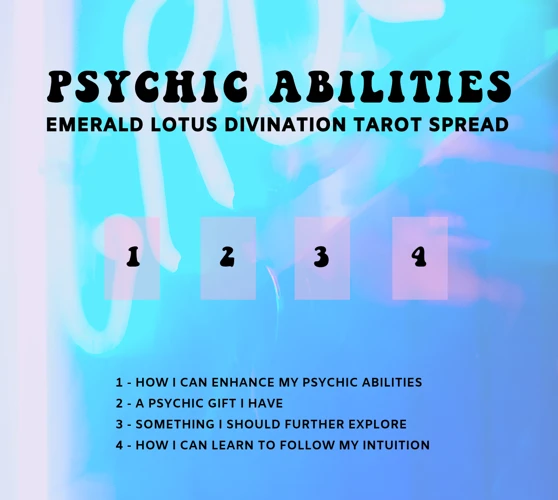
When it comes to tarot card readings, there are several common spreads that readers use to lay out the cards and gain deeper insight into specific areas of life. One popular spread is the Celtic Cross Spread, which provides a comprehensive look at a person’s past, present, and future, as well as their subconscious influences and potential outcomes. Another common spread is the Three-Card Spread, which focuses on the past, present, and future in a more simplified manner. This spread is perfect for quick answers or for gaining clarity on a specific situation. The Relationship Spread, as the name suggests, is specifically designed to explore matters of the heart, providing insights into the dynamics and potential outcomes of a romantic relationship. Each of these spreads offers a unique perspective and tells a different story based on the placement and interpretation of the cards. By using these spreads, tarot card readers can delve deep into the energies surrounding a particular situation and provide valuable guidance and insights.
Celtic Cross Spread
The Celtic Cross spread is one of the most popular and widely used tarot card spreads. It consists of ten cards laid out in a specific pattern that provides deep insight into a situation or question. To begin the Celtic Cross spread, the reader will have the querent (the person receiving the reading) shuffle the deck while focusing on their question or intention. After the cards are shuffled, the reader will lay out the ten cards in the following manner:
1. The significator card represents the querent and their current state of being. This card provides a foundational energy for the reading and sets the tone for the interpretation.
2. The crossing card is placed over the significator card and reveals any obstacles or challenges that the querent may face in relation to their question or situation.
3. The crowning card reflects the querent’s conscious thoughts and desires. It sheds light on their aspirations or the highest potential outcome of the situation.
4. The base card represents the foundation or underlying influences that are affecting the situation. It signifies the root cause or fundamental energies at play.
5. The past card provides insight into relevant events or influences from the past that have shaped the current circumstances. It can offer a historical context for the situation.
6. The future card offers a glimpse into potential outcomes or developments that may manifest in the future. It helps the querent to gain perspective and prepare for what lies ahead.
7. The self-perception card reflects how the querent perceives themselves within the situation. It reveals their inner thoughts, beliefs, and perspectives.
8. The external influences card represents external factors that may be impacting the situation. It can include people, events, or circumstances that are outside of the querent’s control.
9. The hopes and fears card reveals the querent’s subconscious desires, hopes, or fears regarding the situation. It explores the emotional landscape surrounding the question.
10. The final outcome card provides an overall summary or potential resolution to the situation. It can offer guidance and clarity on what actions or steps to take moving forward.
Each card in the Celtic Cross spread is interpreted individually and in relation to the surrounding cards. It offers a comprehensive analysis of the querent’s situation and provides guidance and insights that can assist in making informed decisions. Remember, the tarot is a tool for self-reflection and guidance, and the Celtic Cross spread is a powerful way to gain a deeper understanding of the energies at play in your life.
Three-Card Spread
The Three-Card Spread is one of the most popular tarot spreads used during a reading. As the name suggests, it involves drawing three cards from the deck and placing them in a specific order. Each card represents a different aspect of the situation or question at hand.
Card 1: Past – This card represents the past influences that have led to the current situation. It offers insights into any events, experiences, or decisions that have shaped the present circumstances.
Card 2: Present – The second card in the spread represents the current state of affairs. It provides clarity on the current energy surrounding the issue and offers guidance on how to navigate through it.
Card 3: Future – This card sheds light on the potential outcomes or future developments related to the situation. It offers insights into the possible paths that may unfold and helps the querent make informed decisions moving forward.
The Three-Card Spread offers a concise yet insightful snapshot of the situation, making it a great option for quick guidance or a general overview. It is versatile and can be applied to various aspects of life, such as relationships, career choices, or personal growth. The simplicity of this spread allows for easy interpretation and understanding, making it suitable for both beginners and experienced readers. So, whether you’re seeking clarity or looking for some direction, the Three-Card Spread can provide valuable insights that can empower you to make informed decisions and take control of your life path.
Relationship Spread
A Relationship Spread is a popular tarot card spread that focuses specifically on love and relationships. It can provide valuable insights into the dynamics, challenges, and potential outcomes of a romantic partnership. This spread typically involves drawing multiple cards and arranging them in a specific pattern to create a story or narrative about the relationship. Each card in the spread represents a different aspect or perspective, shedding light on both the strengths and weaknesses of the relationship. For example, the first card may represent the current state of the relationship, while the second card may reveal any obstacles or challenges that need to be addressed. The third card could indicate the potential future outcome or direction of the relationship. By examining the cards and their connections to one another, a tarot card reader can offer guidance and advice on how to navigate the relationship in a more fulfilling and harmonious way. Whether you’re single, in a committed relationship, or facing relationship difficulties, a Relationship Spread can provide valuable insights and guidance for your love life. So, consider trying this tarot card spread if you’re seeking clarity and understanding in matters of the heart.
Ending the Tarot Card Reading
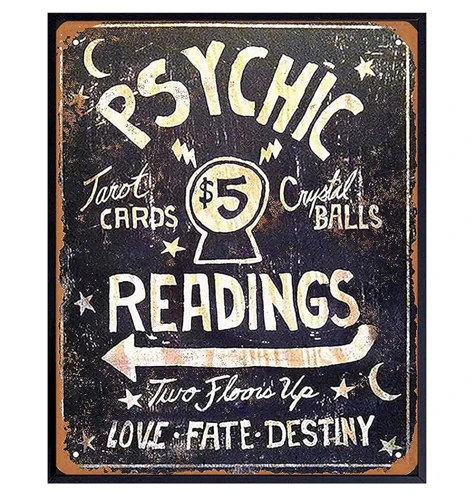
Ending the tarot card reading is just as important as the reading itself. As the session comes to a close, the tarot reader will guide you through the final steps. The reader will begin by summarizing the main themes and messages that emerged during the reading. This serves to tie everything together and ensure you have a clear understanding of the insights gained. Take this opportunity to ask any further questions or seek clarification on specific cards or interpretations. Once you feel satisfied with the information received, the tarot reader will offer any additional guidance or advice that may arise. They may provide suggestions for self-reflection, recommended actions to take, or resources to explore. It’s important to listen attentively and take notes if desired. After the final discussion, the reader will invite you to share any concluding thoughts or feelings you may have. This is a moment of reflection and integration, allowing you to process the information received and connect it with your own intuition and experiences. Finally, the tarot reader will express their gratitude for the opportunity to read for you and conclude the session. As the querent, it is polite to thank the reader as well. Remember, the ending of a tarot card reading is not an abrupt termination but rather a gradual closure that allows for a smooth transition back into everyday life. Take some time after the reading to honor the insights gained and reflect upon how they can positively impact your journey moving forward.
What to Do After the Reading
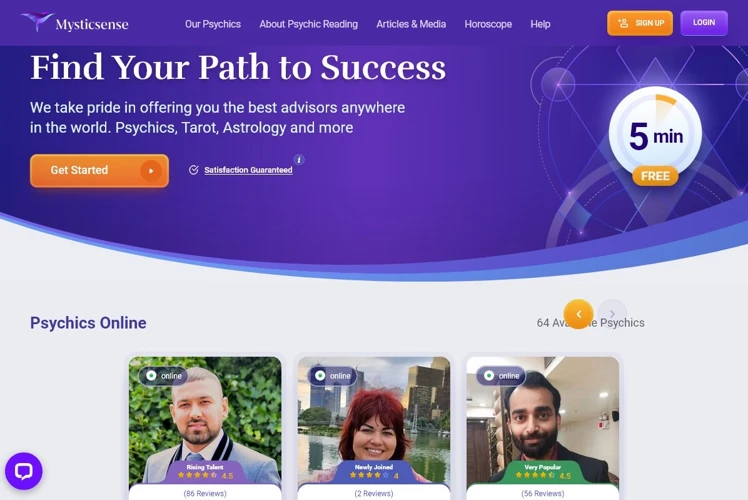
After a tarot card reading, there are a few important steps you can take to make the most of the experience. First and foremost, take some time to reflect on the messages and insights that were revealed during the reading. Allow yourself to process the information and the emotions that may have arisen. It can be helpful to journal about your thoughts and feelings, noting any significant symbols or messages that stood out to you. This will allow you to revisit and analyze the reading in the future. Additionally, it’s important to remember that tarot readings are not set in stone. The cards offer guidance and possibilities, but ultimately, it’s up to you to make choices and take action in your life. Use the reading as a tool for self-reflection and decision-making, but trust your own intuition above all else. It can also be beneficial to seek support or further guidance if needed. Discussing the reading with a trusted friend or a professional can provide additional insights and clarity. Lastly, be patient with yourself. Not all aspects of the reading may make immediate sense, and that’s okay. Sometimes, the true meaning of certain cards or messages unfolds over time. Embrace the journey of self-discovery and growth that the tarot reading has set in motion, and allow yourself to explore the depths of your own intuition and inner wisdom.
Benefits of Tarot Card Readings
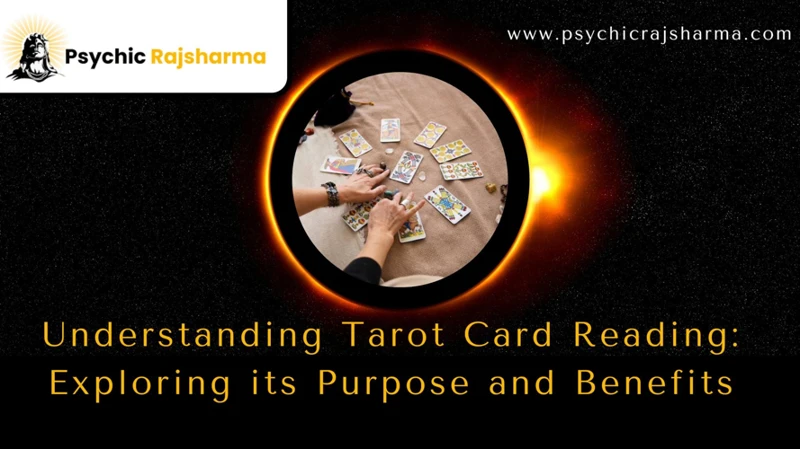
Tarot card readings offer a multitude of benefits that can enhance different aspects of one’s life. Here are some of the key advantages of engaging in tarot readings:
1. Self-reflection and Insight: Tarot cards facilitate introspection, enabling individuals to gain a deeper understanding of their emotions, beliefs, and desires. By reflecting on the card meanings and symbols, the reader can unravel subconscious thoughts and uncover hidden motivations.
2. Clarity and Decision-making: Tarot readings can provide clarity in times of confusion or uncertainty. They offer guidance and help individuals make informed decisions by illuminating various possibilities and potential outcomes.
3. Validation and Confirmation: Tarot acts as a validation tool, confirming hunches or intuitive feelings. It provides reassurance by acknowledging and affirming inner perceptions, giving individuals confidence in their choices and actions.
4. Personal Growth and Empowerment: Tarot readings promote personal growth by highlighting areas of strength and areas for improvement. They encourage individuals to take accountability for their lives, helping them make positive changes and take control of their circumstances.
5. Emotional Healing: Tarot can aid in emotional healing by offering guidance on how to navigate challenging situations, heal past traumas, and release emotional blockages. It provides a platform for emotional expression and fosters a sense of catharsis and healing.
6. Goal Setting and Manifestation: Through tarot readings, individuals can gain insight into their aspirations and align their actions with their goals. The cards can provide guidance on the steps needed to achieve desired outcomes, empowering individuals to manifest their dreams.
7. Increased Self-Awareness: Tarot readings help individuals become more self-aware by shedding light on their strengths, weaknesses, and patterns of behavior. This self-awareness can lead to personal growth, improved relationships, and a deeper understanding of oneself.
8. Spiritual Connection: Tarot readings can foster a deeper connection with one’s spirituality or higher power. The symbolism and archetypes within the cards can resonate with individuals on a spiritual level, providing a sense of comfort, guidance, and connection to something larger than themselves.
It is important to remember that the benefits of tarot card readings may vary from person to person. Nonetheless, the insights gained from a tarot reading can be transformative and serve as a valuable tool for personal growth and self-discovery.
How Often Should You Get a Tarot Card Reading?

The frequency of tarot card readings depends on several factors, including personal preference, the urgency of the situation, and the purpose of the readings. Some individuals may choose to have a tarot reading as a one-time experience, seeking guidance during a specific turning point in their lives. For others, regular tarot card readings can serve as a tool for self-reflection and personal growth. If you’re using tarot as a means of gaining insight and clarity on a consistent basis, it is recommended to space out your readings to allow time for reflection and integration of the messages received. Monthly or quarterly readings can provide a balance between staying connected with the tarot’s guidance and allowing yourself time to apply the insights gained. However, it’s important to listen to your intuition and trust your own judgment when determining how often to get a tarot card reading. Remember, the tarot is a tool for self-empowerment, and it’s ultimately up to you to decide what feels right for your own spiritual journey.
Choosing a Tarot Card Reader

Choosing a tarot card reader is a crucial step in ensuring a meaningful and accurate reading. Here are some factors to consider when selecting a tarot card reader:
1. Experience: Look for a reader with ample experience in tarot card readings. Experienced readers have a deep understanding of the cards and can provide insightful interpretations.
2. Reputation: Research the reputation of the tarot card reader. Read reviews and testimonials from previous clients to get an idea of their authenticity and accuracy. A reputable reader will have positive feedback and a track record of satisfied clients.
3. Specialization: Consider if you have a specific area of focus or question in mind. Some tarot card readers specialize in love and relationships, while others may have expertise in career guidance or spiritual development. Choose a reader who aligns with your needs.
4. Connection: It’s important to feel a connection or resonance with your tarot card reader. Trust your intuition and choose someone with whom you feel comfortable sharing personal insights and vulnerabilities.
5. Ethical Standards: Ensure that the tarot card reader maintains ethical standards and practices. They should prioritize your well-being and provide a safe and confidential space for the reading.
6. Pricing: Take into account the pricing of the tarot card reader. While it’s important to consider your budget, also remember that a higher price does not necessarily guarantee a better reading. Focus on the reader’s expertise and reputation rather than solely on the cost.
By considering these factors, you can make an informed decision when choosing a tarot card reader who will provide you with an insightful and meaningful reading. Remember, the connection between you and the reader is key to a successful and impactful session.
Final Thoughts
A tarot card reading can be a powerful tool for self-discovery, guidance, and insight. It allows individuals to tap into their own intuition and subconscious mind, providing clarity and direction in various aspects of life. Whether you believe in the mystical aspects of tarot or view it as a psychological tool, there is no denying the transformative potential it holds. It is important to approach a tarot card reading with an open mind and realistic expectations. Remember, the cards themselves do not hold all the answers, but rather serve as a catalyst for self-reflection and introspection. After a reading, take some time to reflect on the messages and insights you have received. Consider how they resonate with your current situation and what actions you can take to move forward. Ultimately, trust your own instincts and intuition when interpreting the reading. If you find the experience beneficial, you may choose to explore tarot further and incorporate it into your personal growth journey. Whether you are seeking guidance, clarity, or simply a new perspective, a tarot card reading can provide valuable insights and support on your life path.
Conclusion
In conclusion, a tarot card reading can provide valuable insights, guidance, and self-reflection. It is a powerful tool for gaining clarity and understanding in various aspects of life. By exploring the symbolism and meanings of the cards, individuals can delve into their subconscious mind and tap into their intuition. Tarot readings are not about predicting the future with certainty, but rather about empowering individuals to make informed choices and navigate life’s challenges. Whether you’re seeking answers to specific questions or simply looking for guidance on your life path, a tarot card reading can offer a fresh perspective and shed light on important areas of your life. Remember, it’s essential to approach tarot with an open mind and trust in the process. So, embark on this mystical journey of self-discovery and embrace the wisdom that the tarot has to offer.
Frequently Asked Questions
What can tarot cards reveal about my future?
Tarot cards aren’t designed to predict the future with certainty. Instead, they offer insights and guidance based on current energies and potential outcomes. The future is not set in stone and can be influenced by our actions and choices.
Can anyone learn to read tarot cards?
Yes, anyone with dedication and an interest in tarot can learn to read the cards. It requires practice, intuition, and a willingness to connect with the symbolism and meanings of the cards.
Are online tarot readings accurate?
Online tarot readings can be just as accurate as in-person readings. However, it’s essential to choose a reputable and experienced reader who can connect with you energetically, even from a distance.
Do tarot cards have negative or scary meanings?
Tarot cards can depict both positive and challenging aspects of life. While some cards may appear unsettling, their purpose is to offer guidance and encourage personal growth, rather than to instill fear.
Is a tarot reading limited to a specific time frame?
No, a tarot reading can encompass past, present, and future influences. The reader can guide you to gain clarity on your current situation and explore potential paths ahead.
Can tarot cards provide solutions or make decisions for me?
Tarot cards can provide insights and perspectives, but ultimately, the decisions and actions are up to you. The cards serve as a tool for self-reflection, helping you tap into your intuition and make informed choices.
Can I ask specific questions during a tarot reading?
Absolutely! Specific questions can help focus the reading and provide more personalized guidance. However, keep in mind that open-ended questions often yield deeper insights.
How long does a tarot reading usually last?
The duration of a tarot reading can vary depending on the reader and the type of reading. It can range from 30 minutes to an hour or longer, depending on the depth of exploration and discussion.
Can tarot cards reveal information about my love life?
Yes, tarot cards can provide insights into your love life, relationships, and the dynamics at play. They can offer guidance on finding love, improving existing relationships, or understanding patterns in your romantic life.
Are tarot readings only for predicting events, or can they offer personal growth?
Tarot readings are not solely for predicting events. They offer a pathway for personal growth, self-discovery, and gaining a deeper understanding of yourself and the world around you. Tarot can provide valuable insights and guidance for various aspects of life.







